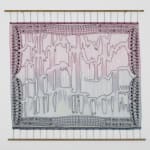Vivian Caccuri
Lindóia, 2024
tela de mosquiteiro, algodão encerado, algodão, resina acrílica e latão
[mosquito netting, waxed cotton, cotton, acrylic resin and brass]
[mosquito netting, waxed cotton, cotton, acrylic resin and brass]
101 x 106 x 2 cm
[39 3/4 x 41 3/4 x 3/4 in]
3 kg
[39 3/4 x 41 3/4 x 3/4 in]
3 kg
Copyright O Artista
Mais imagens
Em Sonograma, gráficos sonoros de faixas de música, conversas e outras gravações de áudio tornam-se a matéria-prima para a construção de peças abstratas que fazem uso da cor, da linha,...
Em Sonograma, gráficos sonoros de faixas de música, conversas e outras gravações de áudio tornam-se a matéria-prima para a construção de peças abstratas que fazem uso da cor, da linha, do ritmo e do comprimento para exprimir a relação entre o tempo e espaço. Pintados em grandes telas de mosquiteiro – material recorrente na produção de Caccuri, que a acompanha desde suas primeiras pesquisas sobre o mosquito Aedes Aegypti –, as composições são desfiadas e, em seguida, talhadas, conservando na matéria sintética apenas os resquícios das ondas originais. Neste processo, Caccuri busca eliminar as camadas de literalidade do som, como as palavras e ruídos que designam uma ação ou um objeto, isolando apenas os dados abstratos oriundos da visualização gráfica do som.
[In Sonograma, sound data from music tracks, conversations, and other audio recordings become the raw material for abstract pieces built using color, thread, rhythm, and length to express the relationship between time and space. Painted on large mosquito nets - a recurring material in Caccuri’s work, which she has used since her early investigations into the Aedes aegypti mosquito - the forms are embroidered and then unwoven, transferring traces of the original sound waves onto the synthetic matter. Threads embroidered over the mosquito nets combine different fragments of drawings, ranging from expansive and spacious to tiny and intricate.]
[In Sonograma, sound data from music tracks, conversations, and other audio recordings become the raw material for abstract pieces built using color, thread, rhythm, and length to express the relationship between time and space. Painted on large mosquito nets - a recurring material in Caccuri’s work, which she has used since her early investigations into the Aedes aegypti mosquito - the forms are embroidered and then unwoven, transferring traces of the original sound waves onto the synthetic matter. Threads embroidered over the mosquito nets combine different fragments of drawings, ranging from expansive and spacious to tiny and intricate.]







